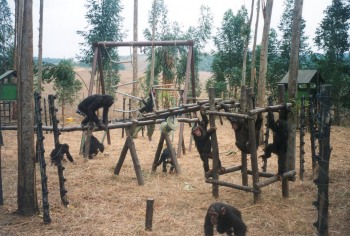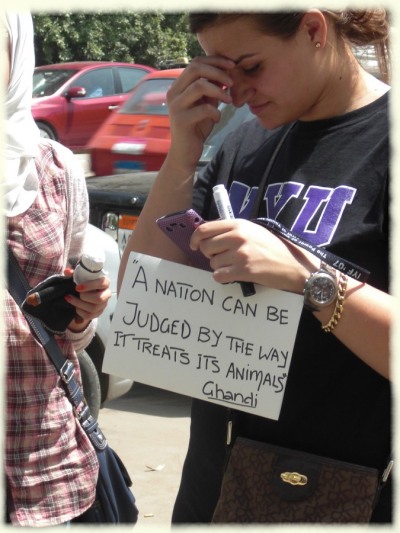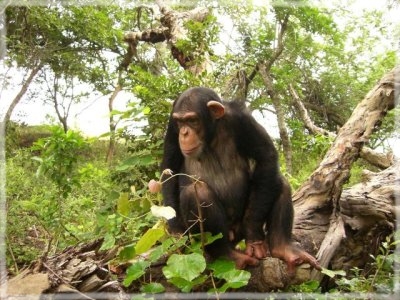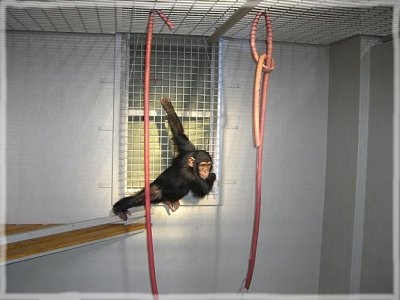|
The Jane Goodall Institute of Italy was set up in December 1998
as the Italian branch of the Jane Goodall Institute
International (JGI) on the initiative of the President the
biologist
Daniela De Donno
Mannini (CV).
JGI Italy is a socially useful non profit making organisation,
its philosophy and aims are based on those of the JGI
International: acting to build a better future for people,
animals and the environment.
THE VISION OF JGI -ITALIA
To contribute to a mindful long-term global development, based
on equal distribution of resources and environment-friendly
choices.
THE OBJECTIVE
To protect and enhance biologic and cultural diversities.
OUR ACTIONS
To promote respect and solidarity.
To support young people in developing greater critical
conscience, individual engagement, self-confidence and hope in
the future.
OUR PROJECTS
-
International cooperation to
development in Tanzania, having particular regard to orphans
because of AIDS.
-
Environmental and
humanitarian education directed towards children and young
people up to university through the international program Roots&Shoots.
-
Animal protection, having
particular regard to chimpanzees as a symbol of those animal
species that are threatened by extinction.
The projects of JGI Italy are:
-
Sanganigwa
Project: for the children of an orphanage in Kigoma,
Tanzania near the Gombe National Park. The Kigoma region of
Tanzania is one of the poorest areas of the world. JGI Italy
supports the cost of food, medicine, schooling and recreation
for 59 Tanzanian children between the ages of 3 and 19 of
different ethnic and religious backgrounds. In addition, their
schooling is supplemented by an internal education programme
which aims to facilitate children over 18 with their entry into
the world of work.
To support the Sanganigwa project, JGI Italy has started up a
programme of “distance
sponsorship”, the programme is directed at both institutions
and private citizens.
- Environmental education:
Roots &
Shoots (italian version) is the environmental
and humanitarian programme dedicated to young people. The aim of
R&S is to teach respect for the
environment, to promote knowledge and understanding of other
cultures and to uphold the importance of every individual’s
commitment. The young people of R&S
are actively involved in projects concerning the local
community, the environment and animals.
-
Teaching about peace and
trans-cultural training (italian version):
Teaching about peace and trans-cultural training: to promote
inter-cultural knowledge and exchange, through a series of
didactic initiatives, a worldwide communication network and
concrete action. Respect and collaboration between citizens from
different cultural backgrounds is encouraged by means of
information on the origins and development of other societies.
Trans-cultural education directed at both young people and
adults greatly supports the process of social integration which
also requires an ever greater commitment to training in many
spheres, including the world of work.
- “So like us” (italian
version) programme: to expose the often deplorable
conditions of chimpanzees in captivity, to monitor and protect
chimps in captivity and to teach greater respect for this
species which is so similar to our own. Chimps should live
freely in the protected forests of Africa, if, unfortunately,
captivity is forced upon them then the structures in which they
live should be able to guarantee their well-being and
behavioural harmony. What’s more these structures have the
fundamental task of increasing public awareness of this species
as much as possible: that chimps too, just like people, prefer
to be free and that their natural habitats are unique and in
need of protection.
|
|
SOME NEWS
- Nando Peretti Foundation and JGI-Italy for
Tchimpounga Chimpanzee Rehabilitation Center (TCRC).
(January 2013)
The
Nando Peretti Foundation
 and
the Jane Goodall Institute Italia together for the
Tchimpounga Chimpanzee Rehabilitation Center (TCRC), managed
in Congo Brazzaville by the JGI for chimpanzees taken away from
poachers and illegal commerce. For the past 20 years, the Jane
Goodall Institute (JGI) has worked tirelessly to ensure the
well-being of orphaned chimpanzees confiscated by the Congolese
authorities in their efforts to stop the illegal commercial
bushmeat and pet trades. They are cared for at JGI’s
Tchimpounga Chimpanzee Rehabilitation Center (TCRC), the
largest chimpanzee sanctuary in Africa. Established in 1992, the
Tchimpounga Chimpanzee Rehabilitation Center (TCRC) provides
sanctuary for chimpanzee orphans, all victims of either the
illegal bush and
the Jane Goodall Institute Italia together for the
Tchimpounga Chimpanzee Rehabilitation Center (TCRC), managed
in Congo Brazzaville by the JGI for chimpanzees taken away from
poachers and illegal commerce. For the past 20 years, the Jane
Goodall Institute (JGI) has worked tirelessly to ensure the
well-being of orphaned chimpanzees confiscated by the Congolese
authorities in their efforts to stop the illegal commercial
bushmeat and pet trades. They are cared for at JGI’s
Tchimpounga Chimpanzee Rehabilitation Center (TCRC), the
largest chimpanzee sanctuary in Africa. Established in 1992, the
Tchimpounga Chimpanzee Rehabilitation Center (TCRC) provides
sanctuary for chimpanzee orphans, all victims of either the
illegal bush meat
or live animal trade. Over the past twenty years, 192
chimpanzees have called Tchimpounga home. Today, 155 live here.
The current facilities as per the Pan African Sanctuary Alliance
(PASA) minimum standards are suitable for housing no more than
88 individuals. Currently, out of the 155, there are 142
individuals being housed within these facilities. The ability to
expand to provide suitable facilities no longer exists at this
site. Moreover, each year, Tchimpounga is under attack from
grass fires that are lit by local villages near or inside the
reserve. On average, the staff at Tchimpounga will fight up to
10 fires each dry season, trying to protect the forests and the
sanctuary from these fires. Since 2004, the Jane Goodall
Institute (JGI) has been searching for a solution to the
expanding orphan chimpanzee population at the old site. The
government of Congo agreed to expand the Tchimpounga Nature
Reserve (TNR) from 75km2 to 555km2, including three islands:
Tchindzoulou, Ngombe and Tchibebe. JGI just acquired the three
uninhabited islands on the Kouilou River which is adjacent to
the TCRC and within the expanded Tchimpounga Natural Reserve. Il
JGI sta attualmente spostando gli scimpanzé nella nuova area. With the cooperation and assistance of the Congolese Government
and other partners we are now working to create an expanded and
improved long-term site on these islands for the chimpanzees
where they can continue to be cared for and given the chance to
thrive and live happier lives in conditions reflective of
natural chimpanzee habitat. JGI’s long-term vision for the
expanded TCRC also includes opportunities to educate local
residents on environmental issues, and to generate tourist
revenue which will assist in funding ongoing TCRC operations,
and boost the local economy. Together with the Tchimpounga
director, Rebeca Tencia and the JGI expert JGI Debby Cox, the
Jane Goodall Institute Italia and
Nando Peretti Foundation (NPF) designed a supporting
programme for the Tchimpounga Cnter, in this decisive moment in
its history. In particular, NPF and JGI will purchase a boat,
life jackets and protection panels to be put on the island, with
the specific purpose to ensure security and therefore
sustainability to the project. meat
or live animal trade. Over the past twenty years, 192
chimpanzees have called Tchimpounga home. Today, 155 live here.
The current facilities as per the Pan African Sanctuary Alliance
(PASA) minimum standards are suitable for housing no more than
88 individuals. Currently, out of the 155, there are 142
individuals being housed within these facilities. The ability to
expand to provide suitable facilities no longer exists at this
site. Moreover, each year, Tchimpounga is under attack from
grass fires that are lit by local villages near or inside the
reserve. On average, the staff at Tchimpounga will fight up to
10 fires each dry season, trying to protect the forests and the
sanctuary from these fires. Since 2004, the Jane Goodall
Institute (JGI) has been searching for a solution to the
expanding orphan chimpanzee population at the old site. The
government of Congo agreed to expand the Tchimpounga Nature
Reserve (TNR) from 75km2 to 555km2, including three islands:
Tchindzoulou, Ngombe and Tchibebe. JGI just acquired the three
uninhabited islands on the Kouilou River which is adjacent to
the TCRC and within the expanded Tchimpounga Natural Reserve. Il
JGI sta attualmente spostando gli scimpanzé nella nuova area. With the cooperation and assistance of the Congolese Government
and other partners we are now working to create an expanded and
improved long-term site on these islands for the chimpanzees
where they can continue to be cared for and given the chance to
thrive and live happier lives in conditions reflective of
natural chimpanzee habitat. JGI’s long-term vision for the
expanded TCRC also includes opportunities to educate local
residents on environmental issues, and to generate tourist
revenue which will assist in funding ongoing TCRC operations,
and boost the local economy. Together with the Tchimpounga
director, Rebeca Tencia and the JGI expert JGI Debby Cox, the
Jane Goodall Institute Italia and
Nando Peretti Foundation (NPF) designed a supporting
programme for the Tchimpounga Cnter, in this decisive moment in
its history. In particular, NPF and JGI will purchase a boat,
life jackets and protection panels to be put on the island, with
the specific purpose to ensure security and therefore
sustainability to the project.
http://www.janegoodall.org/chimpanzees-rescue
http://www.nandoperettifound.org/en/page.php.
- JGI and Giza zoo -Cairo.
(March 2012)
The collaboration between the Cairo zoo and the Jane Goodall
Institute continues. After the enrichment and grouping of the
chimpanzees carried out by the JGI behaviourist Hila Terez from
the Phoenix zoo, the JGI-Italia took it upon itself to provide
the new structure that will be hosting two orang outangs and the
chimpanzees area with automatic water troughs. The water
troughs, neither available nor used in Egypt, are made in Italy
and they were delivered to the Giza zoo by the president of the
JGI Italia on March 12. President De Donno together with Dina
Zulfikar from the Egyptian Animal Welfare Federation, delivered
the machines to the Egyptian zoos Director and undersecretary of
State Fatma Tammam and the zoos veterinary unit manager Dr.
Maha.

Photo© Maha, De Donno and Tammam |

Photo© De Donno and Tammam |

Photo© Zulficar, De Donno and Tammam |
- Jane Goodall Grand Officer Order of Merit
of the Italian Republic.
Daniela De Donno Mannini, President of the Jane Goodall
Institute-Italia
Translation Maria Selene Polli (Scuola Superiore Carlo Bo)
(Milano, 21st November 2011)
In the course of 2011, the Jane Goodall Institute in Italy (JGI
Italia) is celebrating Jane Goodall who today, on the occasion
of the “International
Year of Forests”, will receive the honour of “Grand
Officer Order of Merit of the Italian Republic” from the
President of the Republic of Italy Giorgio Napolitano. Jane
Goodall has been dedicating her life to scientific knowledge and
to the protection of the environment since 1960, setting herself
as an example and guide to hundreds of thousands of scientists
and young people all over the world. It has now been fifty years
since Jane Goodall started her scientific observations in the
Gombe Forest to understand how the chimpanzee, the closest
living creature to man, lives. At present, receiving messages
from the other side of the world in real time has been made
possible and the globalisation of markets makes us long for the
greengrocer across the street with sustainable development being
looked upon as pure fiction, it appears difficult for us to
believe that in 1960 nothing was known about these animals. Jane
discovered that they live in organised societies, they have
lifelong relationships, they adopt the orphaned young, use tools
for specific purposes, respond to the “call” of the sound of
waterfalls with exhibitions of power and they fight to grant
themselves more resources. This behaviour rings a bell, in fact
man is its natural cousin.
Jane Goodall has become a living symbol who travels all over the
world to explain, especially to young people, how things stand
and how we can and must change, to really elevate ourselves to
becoming a sensible species, to become the most notable and
gifted one. During her conferences she never misses the chance
to communicate the need of living responsibly and modifying our
lifestyle in order to reduce environmental exploitation.
According to Jane Goodall knowledge is the tool for change,
because only after penetrating and taking in the world and other
cultures can we reach understanding, and only after
understanding can we respect, protect and learn to live with
others. Many years of experience on the field hahe led Jane
Goodall to associate the study of chimpanzees, which nonetheless
has never been interrupted, to natural preservation. This was
quite a natural step for an exceptional woman who witnessed,
from a scientist’s point of view, the rapid and relentless
reduction of the chimpanzees’ magnificent environment and of the
communities who live on the edge of the forest which is her
field of study. Far from standing there and watching things
happen, understanding the urgency of matters, Jane decided to
commit to the conservation of biodiversity and the fulfilment of
projects dedicated to helping the local communities adopt
responsible development too.
When I met Jane Goodall in Burundi back in 1992, where I was
working as a volunteer in her Institute in Bujumbura, directed
by the Australian veterinarian Susanne Abilgaard, what struck me
most was her tenacity. The police used to bring chimpanzees and
gorillas confiscated from dealers who stole the cubs from their
natural destiny by killing the rest of their family so as to
sell them as pets, show or laboratory animals or as bush meat.
In ’92 Jane Goodall was already famous for her discoveries and
already an icon of National Geographic. She teaches us that
every one of the beings she has studied has a different
character and capabilities which render them unique. Goodall was
already in the university zoology books that inspired me so much
at the time and universally recognised for having definitely
erased the clear borderline which separated man from the other
animals.
With these accomplishments Jane Goodall could have easily and
comfortably awaited interviews and honours in the magical Park
of Gombe in Tanzania or in her house in England surrounded by
her birches, instead she was there with volunteers such as
myself to set up divulgating exhibitions and presentations for
the parks’ nearby village schools or rehabilitation centres in
countries such as Tanzania, Burundi or Uganda and kept telling
us just how important our awareness project was, even if we were
to succeed in convincing just one student of the need to protect
the environment, because that single person would have made the
difference and sooner or later we would manage to stop
environmental degradation for a different world that someday
will have to be changed and that someone must do it and do it
quickly too. In the world’s remotest museum, the Tanzanian one
of Ujiji near Lake Tanganica dedicated to the encounter between
Livingston and Stanley that occurred there, Jane Goodall and we
volunteers by her side were preparing for an exhibition on the
chimpanzees to help the local population learn what was about to
disappear just a few feet away from them. It was 1993 and Jane
Goodall, tenacious and tireless as she was in observing
chimpanzees in the forest following them for hours on end
creeping in the underbrush, had embraced the young empowerment
cause, for the environmental awareness and civic
responsibilities: they are the ones who are going to live in
this world and are going to find it disembowelled and fetid,
they are the first to grasp the message, they are the ones who
can change things. It is to them that we must speak, we must
patiently stir. Having had Jane Goodall as an example has been
an exceptional opportunity. Example, using the words of the
great German Doctor Albert Schweitzer, is not the best way to
educate others, but the only one.
Jane Goodall’s battle for our future had already begun in 1977
with the foundation of the Institute “for Research, Education
and Conservation”, that, as it spread, (it can now be found in
26 countries around the world) set concrete projects based on
the concept that the preservation of a territory is linked to
the fate of the populations who inhabit it and that the
eco-systemic, integrated method is the right one to contrast the
disappearance of biodiversity which is caused by man. The
eco-systemic method suggests that the issues of local resource
managing, exploitable or preserved as the resources may be, may
be solved by completely involving those who live in that
determined environment: an integrated method which includes that
the preserved habitat becomes an environment which is
harmonically lived in by the population who interacts with it,
who because of this, must be solid, free from tyrannical
vileness as each depends on the other. We must know and act
responsibly.
Now that we know much more about chimpanzees and living systems
and believe unquestionably that their survival depends mostly on
us, we ask ourselves how to make people responsible also on
behalf of those who cannot defend themselves. In the chaos of
the world crisis that is dazzling Western Civilisation, but that
has always been the status quo of the weakest, we can see some
faint light, maybe because it is wise to think that before we
can surface we need to sink to the bottom although for the
weakest nothing other than the bottom has ever existed. If for
some the election of Obama, President of Afro-Muslim origins,
was just an excellent marketing operation, the Americans’ choice
of a man attentive towards social justice represented a turning
point. Moreover the rebellion of the young Arabs against
dictators, Women’s protests in Saudi Arabia for their rights and
the popular belief that the economic-centred system in which we
live will bring about our suicide and that reducing waste is
fundamental are step changes. Humanity makes us hope that one
day re-surfacing will be possible for all and we’ll live in an
advanced civilisation where the word progress will stand for
social and environmental balance. Indeed we can’t consider
civilised a world that accounts for 215 million children workers
of whom 115 million work in dangerous conditions risking
diseases and death everyday: these are children in Nairobi
dumps, beggars in Tanzania, in Cambodian mines, sex slaves in
Thailand and baby soldiers in Somalia disregarding all
International laws on Human Rights. There are many of us trying
to help them, but it isn’t enough. From the height of her
experience Jane Goodall tells us that we do well in hoping
because our brain and our untameable human spirit will make the
right choices for a better world for everyone. We of the JGL
Italia are committed to this hope when we work for the very poor
community of Kigoma, for the orphaned children and the young
with no future, when we give young Italians the tools to become
confident, when we protect animals and nature. “To achieve
progress” Neuroscientist Tali Sharot teaches us” we must be able
to imagine alternative better realities, and believe that we can
create them”. To believe that with our job we can make others’
conditions and environment better is our ideal, and ideals are
what we have to contrast degradation, to bear sufferings and
obstacles.
- Egypt
for animal welfare. Daniela De Donno from Cairo.
(May 2011)
In these days of milestone changes and dreams to fulfil, public
protest is a way to plant a flag in the name of a just cause. There is a host of political, social and economic
causes to stand up for. But there has been a protest, hidden
under the others in support of the human community well being
and growth, which deserves special attention as well, since it
refers to the principle of respect for all living beings. The
protest has turned out to be a historic moment in the Egyptian
animal rights advocacy and a howl of hope eventually proclaimed
in the name of whom us, human beings, the most intelligent on
earth, have to care for; a call for responsibility. The protest
was on April 16th, in front of the Giza zoo. All historical
Egyptian organizations fighting for the defence of animal rights
where there, all together: ESAF (Egyptian Society for Animal
Friends) with whom my Organization works to promote
environmental education and the welfare of primates, AWAR
(Animal Welfare Awareness Research), ESMA (Egyptian Society for
Mercy of Animals), SPARE (Society for the Protection of
Animals), Donkey Sanctuary, Animal Abuse in Egypt (Group
Hurghada), and a number of foreigners, including myself who was
representing the Jane Goodall Institute and felt honoured to be
part. No religion and no political faith could have divided the
coalition.
just cause. There is a host of political, social and economic
causes to stand up for. But there has been a protest, hidden
under the others in support of the human community well being
and growth, which deserves special attention as well, since it
refers to the principle of respect for all living beings. The
protest has turned out to be a historic moment in the Egyptian
animal rights advocacy and a howl of hope eventually proclaimed
in the name of whom us, human beings, the most intelligent on
earth, have to care for; a call for responsibility. The protest
was on April 16th, in front of the Giza zoo. All historical
Egyptian organizations fighting for the defence of animal rights
where there, all together: ESAF (Egyptian Society for Animal
Friends) with whom my Organization works to promote
environmental education and the welfare of primates, AWAR
(Animal Welfare Awareness Research), ESMA (Egyptian Society for
Mercy of Animals), SPARE (Society for the Protection of
Animals), Donkey Sanctuary, Animal Abuse in Egypt (Group
Hurghada), and a number of foreigners, including myself who was
representing the Jane Goodall Institute and felt honoured to be
part. No religion and no political faith could have divided the
coalition.
The main reason for the protest was to request better living
conditions for animals in the Egyptian zoos, the separation of
Cites from the zoo administration and management, a support to
urban animal conditions, for dogs and cats, as well as donkeys
and horses. The impulse to the protest was the death of one of
the three Orang-utans that had recently arrived, and the
pointless isolation of two chimpanzees, separated for display
reasons regardless of their natural need for socializing with
other chimpanzees. In fact, the situation at Giza zoo has not
changed since my last survey, one year ago, except for the
presence of two Orangos that I didn't see last time. I found the
compound a little cleaner.
For some of the animals conditions are particularly hard. The
two elephants are on a 80 centimeters chain all day, they cannot
turn to scratch their back if they need; this tells you
everything. Other animals are in poor condition, including the
bears, the lions, the apes while several monkeys are kept alone.
Most activities seem to aim at obtaining tips from visitors by
encouraging them to feed the animals or taking pictures to
immortalize the visitor with an animal.
When Dina Zulficar, responsible for the ESAF wildlife unit, told
me about their intention to organize a protest I was skeptical,
I thought it would have gone unnoticed among the many other
events. I was wrong. It was time to move, they had already tried
all possible ways in the past. The persons who were asking for
an improvement of the living conditions of the animals were
those who feed dogs and cats everyday in the streets, who take
stray animals to good hearted veterinaries curing for free, who
lighten donkeys’ loads, who fight violent capture of dolphins
and stop their exhausting performances for the entertainment
business. They try to create awareness among the large majority,
who approach animals only in a utilitarian way.
As a non-Egyptian I was fascinated by the peacefulness of the
protesters during the 25th January revolution. What the Egyptian
society wanted was simply to believe that an honest world is
possible, that equal distribution and social justice are
possible. And even on 16 April in front of the zoo, among these
children, men and women of all ages protesting also in the name
those who cannot talk and ask, let alone fight, I read words of
wisdom: a young women was carrying a sign “a nation can be
judged by the way it treats its animals. Ghandi”.
We have to believe our action can make a difference.
It is possible to see some images of the demonstration at the
following link:
http://wildlife-eg.yolasite.com/protest-pictures-16-april.php
- At last Cozy returns to Africa: his life
has seen only neglect and exploitation but now Cozy the
chimpanzee is being moved to a Jane Goodall Institute oasis in
South Africa.
(August 2006)
In collaboration with the
CITES Service of the Italian State Forestry Corps the Jane
Goodall Institute in Italy (JGI Italia) has rescued a nine-year-old male chimp that was being kept in a
caravan in the Province of Ancona, Italy and has arranged for
his transfer to the sanctuary “JGI Chimpanzee Eden” in South
Africa directed by Eugene Coussons. Taken away from his mother
at the age of one Cozy, as he is called, was legally sold by
American traders to an Israeli juggler who trained him for small
travelling shows. Cozy performed on tour in Europe until in 2003
his owner fell ill and died in an Italian hospital. While
waiting to see what would become of him, he was kept in a cage
inside a camper van for three years without once seeing
daylight. His only consolation was the care of the one-time
partner of the juggler, who looked after him although not
without considerable difficulty.
has rescued a nine-year-old male chimp that was being kept in a
caravan in the Province of Ancona, Italy and has arranged for
his transfer to the sanctuary “JGI Chimpanzee Eden” in South
Africa directed by Eugene Coussons. Taken away from his mother
at the age of one Cozy, as he is called, was legally sold by
American traders to an Israeli juggler who trained him for small
travelling shows. Cozy performed on tour in Europe until in 2003
his owner fell ill and died in an Italian hospital. While
waiting to see what would become of him, he was kept in a cage
inside a camper van for three years without once seeing
daylight. His only consolation was the care of the one-time
partner of the juggler, who looked after him although not
without considerable difficulty.
(Fig1: "Chimpanzee Eden" - Photo © Eugene Coussons/JGI - South
Africa.)
The
CITES Service immediately did all they could to find a
suitable place for the chimp to live. As has been the case in
the past, collaboration with the Jane Goodall Institute was
crucial, this international no-profit organisation has been
dedicated to the conservation of chimpanzees and their natural
environment for years, as well as to environmental education and
to cooperation in favour of development. The “JGI Chimpanzee
Eden”, a wildlife sanctuary within the Umhloti Nature Reserve in
Mpumalanga, in the heart of South Africa, is the largest of all
the African reserves, both in terms of its geographical
extension and its infrastructure. The Jane Goodall Institute
sanctuary is the perfect solution for Cozy as it will allow for
his rehabilitation and partial return to nature.
 The
Jane Goodall Institute has always been opposed to the use of
primates for entertainment and advertising, as well as being
in profound contrast with their normal life and habits, the
apes are also subjected to physical and psychological
violence. After this they take their places in the queue of
chimpanzees who are over 6-8 years old and as such are no
longer of use in the entertainment business; while waiting
to be relocated they are kept in squalid zoos or put down by
euthanasia. The
Jane Goodall Institute has always been opposed to the use of
primates for entertainment and advertising, as well as being
in profound contrast with their normal life and habits, the
apes are also subjected to physical and psychological
violence. After this they take their places in the queue of
chimpanzees who are over 6-8 years old and as such are no
longer of use in the entertainment business; while waiting
to be relocated they are kept in squalid zoos or put down by
euthanasia.
(fig2:
"Quarantine Area" - Photo © Eugene Coussons/JGI - South
Africa.)
It is clear that “Operation Cozy” has required considerable
effort, both from the Forestry Corps and the Jane Goodall
Institute. There are high expectations for the success of
the initiative thanks to the presence of the specialists
from the
CITES Service, vets from the ASUR and experts from the
Jane Goodall Institute in Italy and in South Africa.
Photographic material is available on request to:
.
|